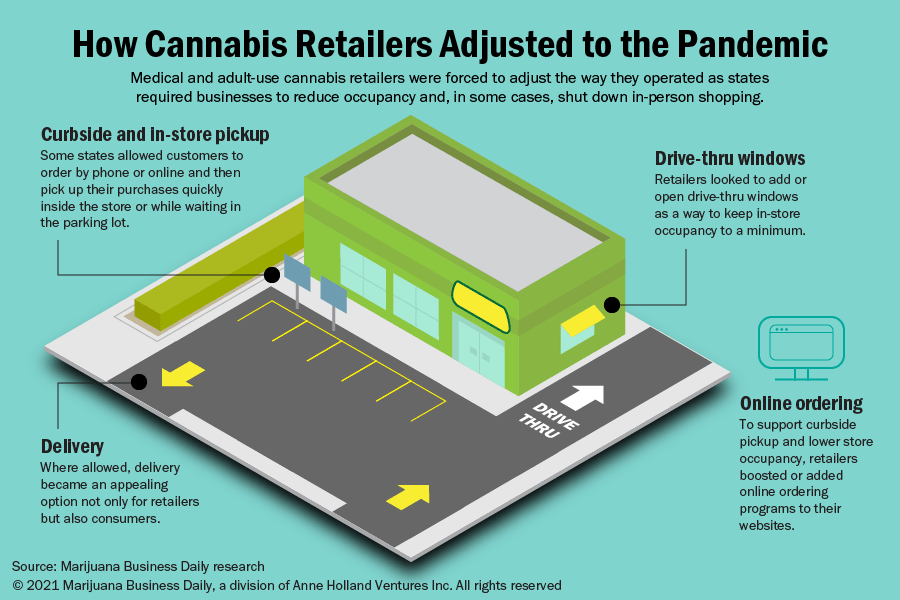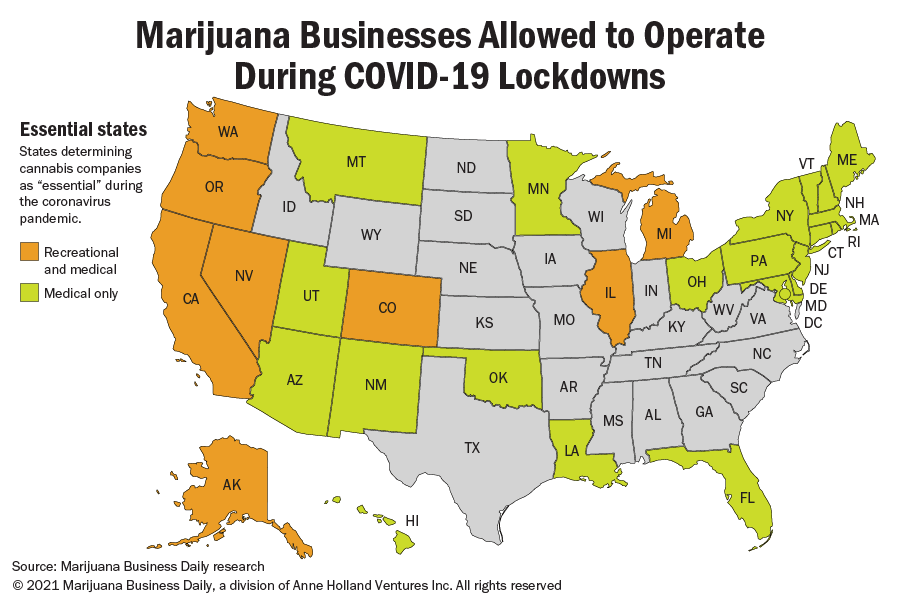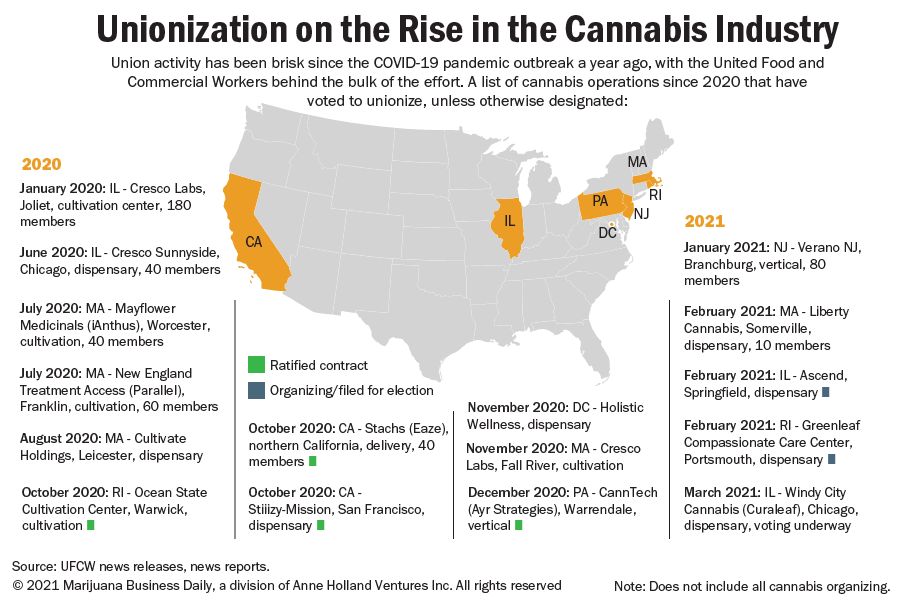Despite challenges such as rapid regulatory change, shifting public-health demands and economic uncertainty, cannabis retailers say the first year of the COVID-19 pandemic has driven beneficial changes to their business models and motivated regulators to permit new ways of serving customers.
Those new services range from online ordering to home delivery and curbside pickup to even drive-thru windows, all of which are helping cannabis retailers maintain and even grow sales during the pandemic.
“I think it’s been positive,” Talley Wettlaufer, senior vice president of retail at cannabis multistate operator Curaleaf, told Marijuana Business Daily.
“From a retail-experience standpoint, it has asked us to adapt and build more ways for us to deliver an outstanding customer experience and continue to meet our customers and patients wherever they are.”
Those adaptations have included:
- Launching online cannabis sales for pickup or delivery, where allowed by regulators.
- Adjusting to new purchasing trends, such as a preference for stocking up on bulk products when shopping trips are less frequent.
“It’s important for us to offer online and delivery where we can but also have an exceptional in-store experience,” Wettlaufer said.
Propelling a pivot to e-commerce
The COVID-19 pandemic served as a catalyst that accelerated the marijuana retail sector’s shift toward e-commerce, said Alexis Mora, head of marketing at California dispensary chain Harborside.
Serendipitously, Harborside launched online ordering about a month before public-health-spurred lockdowns arrived in March 2020.
“When March hit, our curbside and delivery were outpacing, in terms of our retail channels, our in-store sales by about 30% to 40%,” Mora said.
Even though online ordering was already the norm for many other retail sectors, Curaleaf’s Wettlaufer observed that cannabis retailers, as a whole, were somewhat behind the curve in adopting e-commerce.
“Had there not been a global pandemic, I think it probably would have been slower to take off than it did within the last year, where people really had to adjust and use technology,” she said.
Regulated marijuana stores in the United States and Canada are generally limited to serving a given jurisdiction, so cannabis e-commerce still doesn’t look like Amazon or eBay. Legal interstate and international cannabis e-commerce remain goals for the future.
But shoppers have shown an appetite for buying cannabis online locally and getting it via home deliveries, where allowed, or through curbside and in-store pickup.
In some areas, the pandemic has helped marijuana e-commerce pair successfully with a quintessentially American innovation: the drive-thru window.
Harborside’s Desert Hot Springs dispensary opened its drive-thru window in late 2019, and Mora said roughly 70% of customers at that location use the service.
In neighboring Arizona, the drive-thru window at The Mint Dispensary’s Tempe location got off to a slow start with “maybe a handful of orders a day” when it debuted in September 2020, said co-founder and CEO Eivan Shahara.
Now, he said, more than 200 drive-thru tickets are served on a typical Friday.
Shahara expects the drive-thru will remain popular even after the pandemic subsides, “and we believe it is going to continue to grow.”
“We’re actually in the process of adding a second drive-thru window, just to keep up with demand,” he added.
Shifting spending patterns, new customers
Retail sales of cannabis have grown impressively during the pandemic, helping marijuana stores avoid the sustained drop in demand that plagued some other retail sectors.

But marijuana shoppers also adjusted their buying habits in response to the pandemic, with data showing a trend toward shopping less often but spending more on each trip.
“As people were more concerned about contagiousness, they didn’t show up to the stores at the same rate, and so when they did show up to the stores, they did buy in larger quantities,” explained Steve White, CEO of marijuana MSO Harvest Health & Recreation.
Mora said Harborside has seen strong performance from bulk flower formats, particularly 14-gram packages, along with shifts in other category trends.
“People aren’t necessarily buying 1-gram pre-rolls, because people aren’t sharing joints anymore,” she said.
“So, what you’re seeing in terms of trends are, your ‘dog-walkers’ which are your 0.3- or 0.5-(gram) pre-roll packs, where you’re buying a pack and it’s, ‘One for (my) friend, one for me.'”
At Curaleaf, Wettlaufer said the frequency of customer visits has remained “fairly consistent” throughout the pandemic. But she believes the pandemic did help accelerate the arrival of new customers, particularly since many marijuana stores have been recognized as an essential service.
“It’s obviously been a very stressful time, there’s been a lot of people dealing with a lot, and people’s health and wellness has been (at) the forefront of their mind.”
Other external factors also likely drove increased marijuana sales during the pandemic, pointed out Jaclynn Pehota, who, as executive director of the Association of Canadian Cannabis Retailers, represents a group of mostly independent marijuana retailers in British Columbia.
For example, she observed, Canada’s 2020 run-up in cannabis sales correlated not only with the pandemic but also with a significant increase in licensed cannabis stores in major markets such as Ontario.
“But what I have heard anecdotally, from members of the public, is that they think twice about their source of cannabis in a way that they have not had to think about before the pandemic,” Pehota said.
As was done in many U.S. markets, regulators in British Columbia opened up new options for cannabis retailers during the pandemic by allowing online payments for in-store pickup.
British Columbia has a long history of illicit marijuana cultivation, and Pehota said the unregulated market is still thriving.
She’s hopeful the provincial government sees regulated cannabis e-commerce as more than just a temporary, pandemic-era tool and allows private-sector retailers to offer delivery.
“I suspect that our regulators are looking at delivery as a mechanism to compete with the unregulated market, as well as a measure to assist with the prevention of community spread, which, to me, would imply that is going to be a measure that is going to continue into our new normal.”
Looking to the future
Wettlaufer of Curaleaf expects the post-pandemic future of cannabis retail to balance the convenience of online shopping with the high-touch experience of in-store shopping, in line with consumer desires.
“There are some days that you want to browse, and have a conversation, and discover, and be a true shopper – and there are some days where you just want to buy and you want to be fast and frictionless,” she said.
As concern about COVID-19 has subsided, Harvest CEO Steve White said he’s observed consumers returning to stores more often and buying less when they do.
Still, he suspects, “we’re not going to shift all the way back to the pre-COVID behaviors, because we formed new habits over the last year.”
White views the pandemic as a test of cannabis businesses’ strength, offering an analogy by way of a house.
“COVID is one of the many unforeseen weather patterns that test the strength of your house,” he said.
“So, for all of us who have endured it, it may have been true that there were cracks that were exposed in the process – but, the next time, we will be prepared for exactly that same thing to happen again.
“Of course, it will not ever happen again in the exact same way,” White continued.
“But in the process, what you’ve done is you have fortified your foundation and your walls to ensure that other types of unforeseen weather are not going to damage your structure.”
Solomon Israel can be reached at solomon.israel@mjbizdaily.com.





